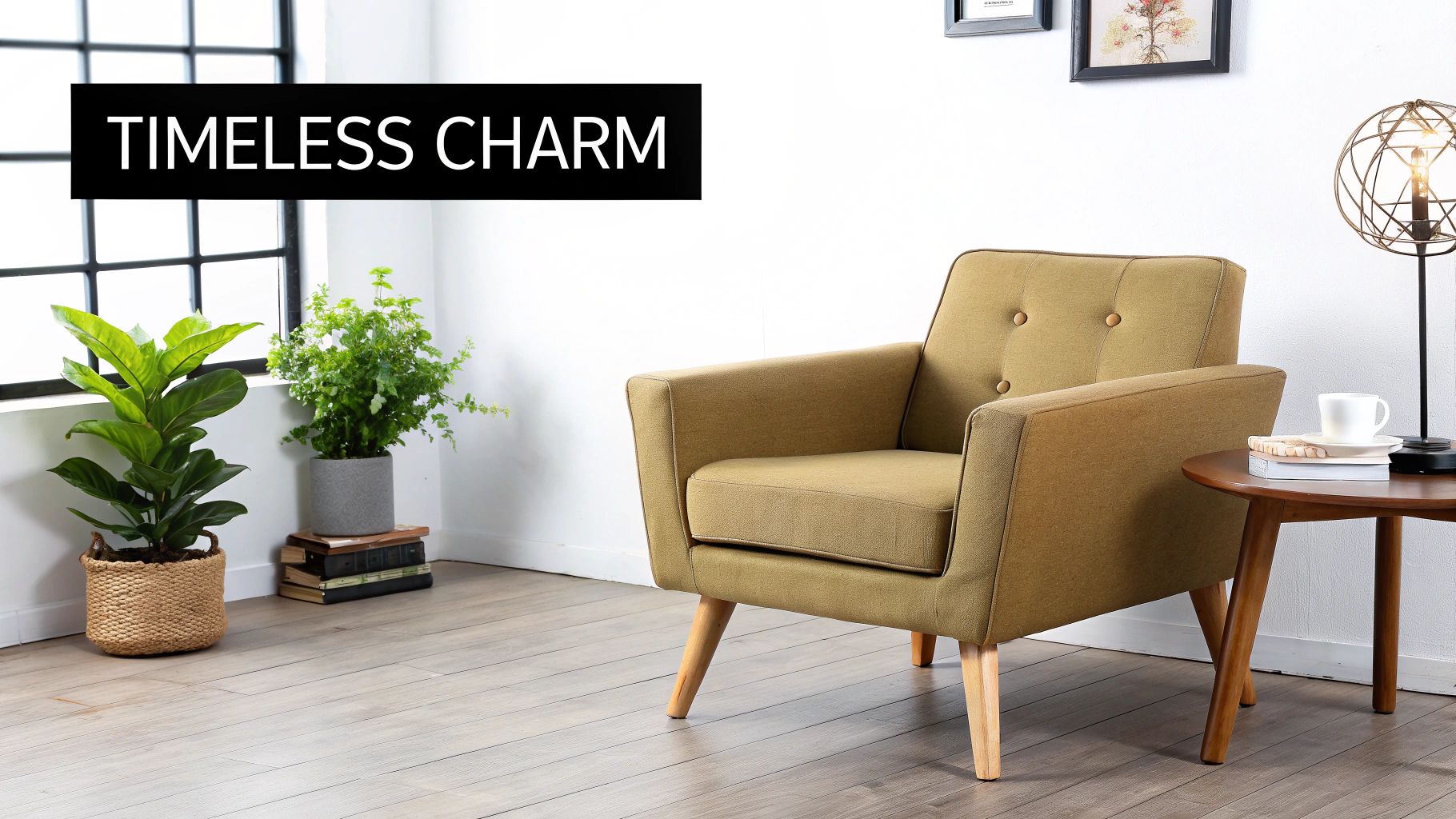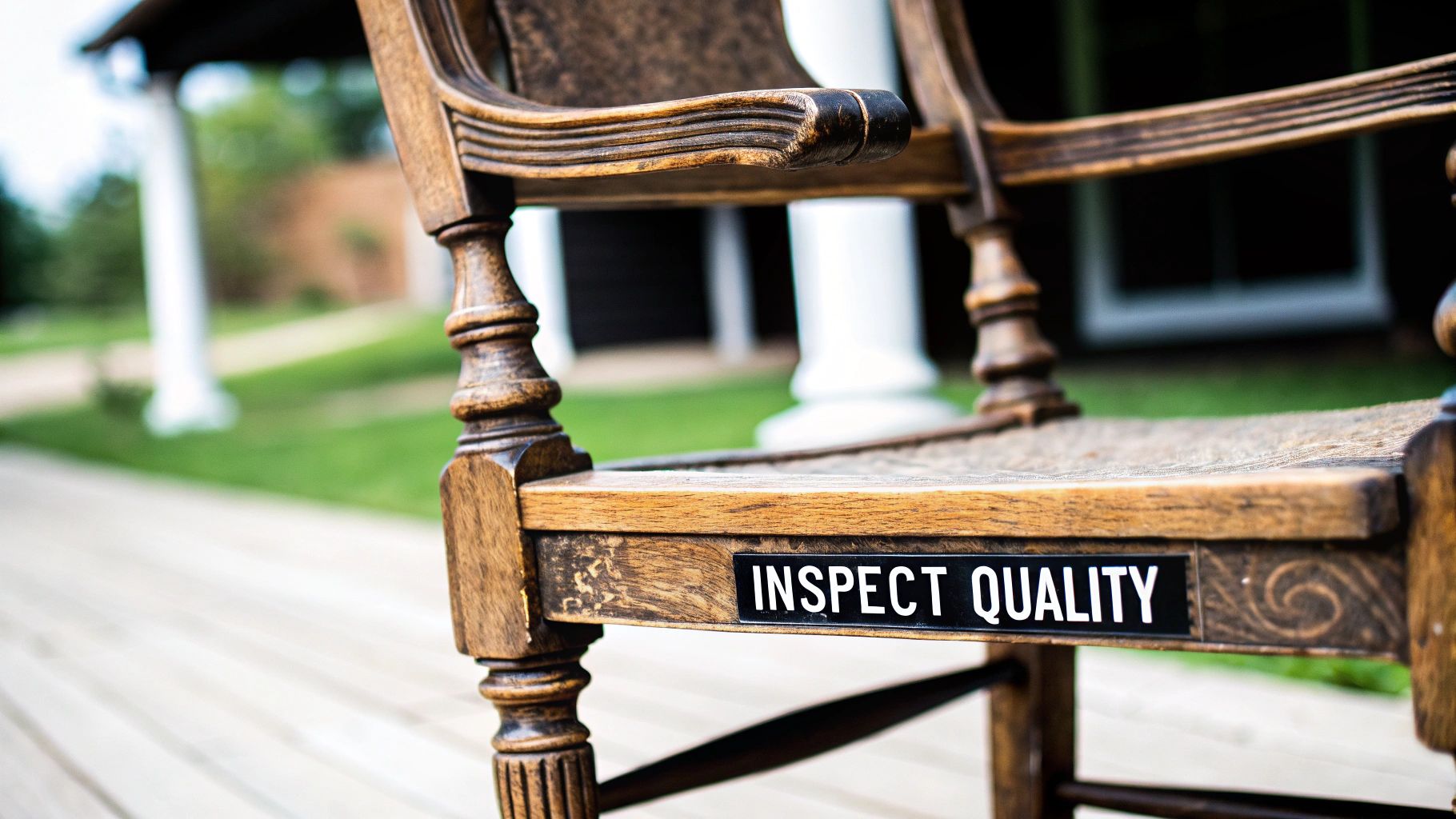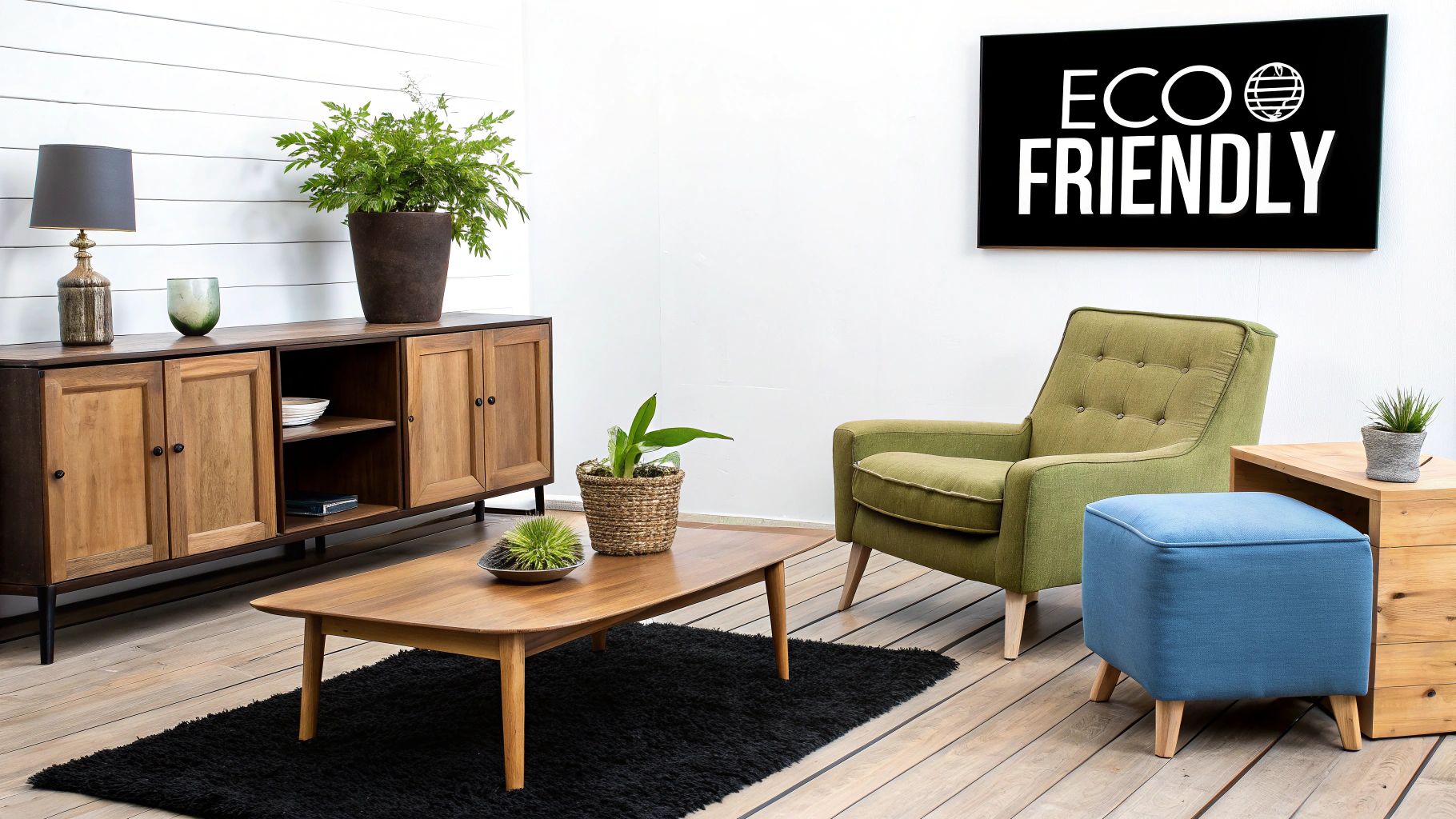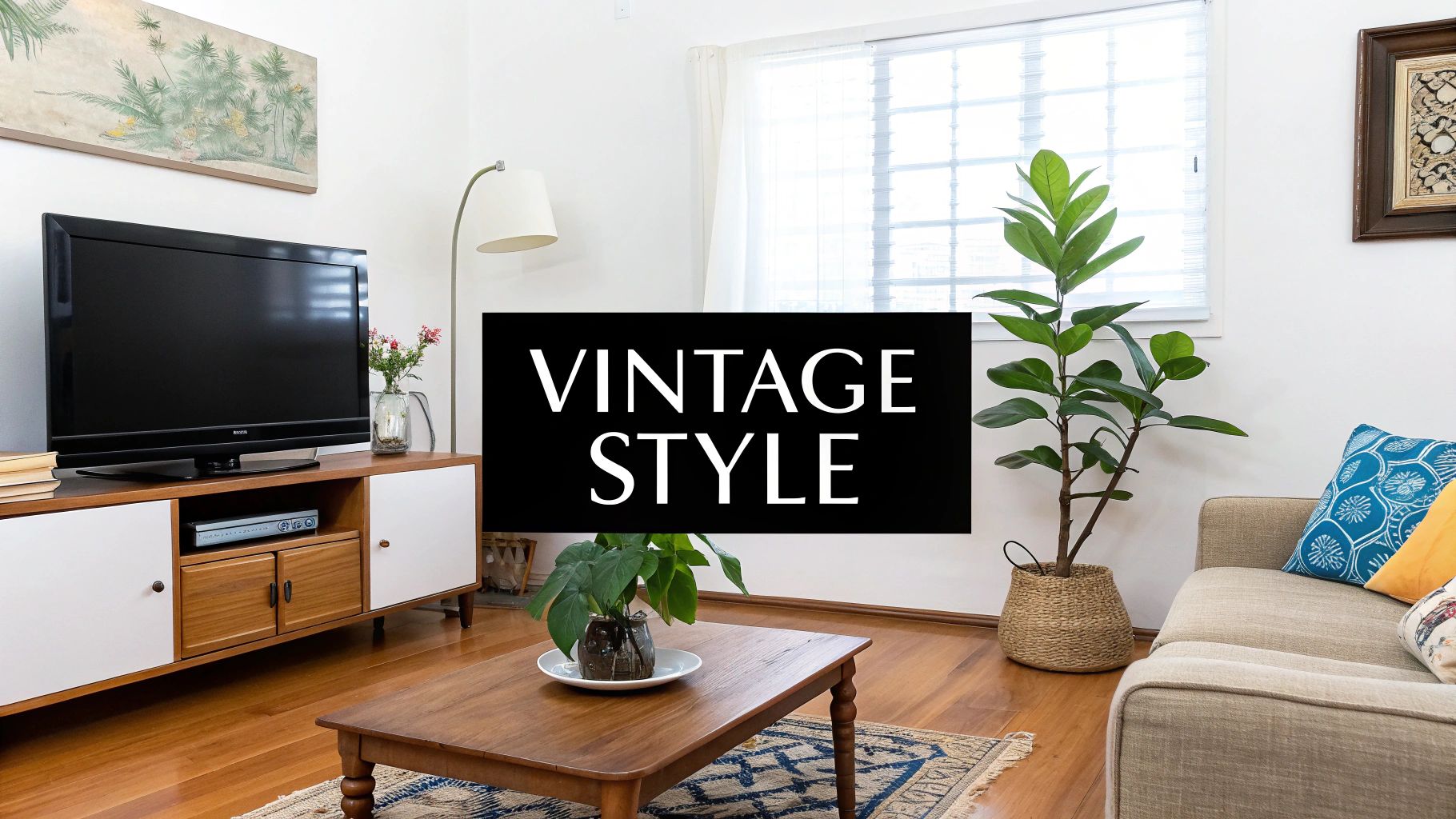Guide to Buying Used Furniture Online: Smart Tips
04.23.25


There’s a noticeable shift happening in interior design. Quality used furniture is gaining popularity, moving beyond its reputation as a budget option to become a sought-after design element for creating unique and stylish spaces. This trend embraces furniture with a history, adding character and a sense of authenticity often missing in mass-produced pieces. It reflects evolving consumer values, with a greater focus on sustainability and expressing individuality.
A primary driver of this shift is the growing appreciation for sustainability. Buying pre-owned furniture keeps usable items out of landfills and reduces the demand for newly manufactured pieces. This, in turn, lessens the environmental impact associated with resource consumption and manufacturing processes. This eco-conscious approach resonates with both designers and consumers. Choosing a vintage armchair, for example, reduces the need for new materials and the energy required to produce a similar piece from scratch.
Another key attraction of quality used furniture is its uniqueness. Each piece has a story, often featuring details and craftsmanship rarely found in modern furniture. This individuality lets designers create spaces with distinct personality, avoiding the uniformity of mass-produced items. A beautifully carved wooden chest from another era, for instance, becomes an instant conversation starter, imbuing a room with a touch of history.
The growth of the second-hand market reflects this growing interest. The global second-hand furniture market is projected to reach USD 56.66 billion by 2030, with a 7.7% compound annual growth rate from 2024. This expansion is driven by a global emphasis on sustainability and environmental awareness, encouraging consumers to choose pre-owned furniture. More detailed statistics can be found in the Grand View Research Second-Hand Furniture Market Report.
While general second-hand sources offer various options, high-end used furniture retailers provide distinct advantages. These retailers specialize in curating exceptional quality pieces, showcasing craftsmanship and design often unavailable elsewhere in the used market. This curation ensures a higher standard, guaranteeing both a stylish addition to a home and a durable, lasting investment. Many also offer services like restoration and authentication, enhancing the value of their offerings.
High-end used furniture provides access to premium brands at reduced prices, often 40-70% below retail. This allows homeowners to furnish their homes with designer pieces without the high cost. This approach to furniture shopping also offers investment potential. Unlike new furniture that depreciates quickly, well-chosen used pieces can retain, and sometimes even increase, their value over time. This makes purchasing high-end used furniture a wise investment for style and financial value. This combination of quality, uniqueness, and value makes quality used furniture increasingly attractive to discerning designers and homeowners.

Finding quality used furniture can feel like a treasure hunt. It takes a keen eye and a bit of know-how to spot truly exceptional pieces. This guide will help you confidently identify furniture worth investing in, separating the gems from the junk. This is especially important when considering high-end used pieces, where the investment can be more significant.
The first thing to assess is the construction. Look for signs of superior craftsmanship that indicate a piece built for the long haul. This is a key difference between high-end used furniture and typical second-hand finds. Examine the joints: dovetail joints, particularly handcrafted ones, are a hallmark of quality. Also, check for solid wood versus veneer. Solid wood offers greater durability and can be refinished, extending its lifespan.
The type of wood matters, too. Hardwoods such as mahogany, walnut, and oak are prized for their strength and beauty. These contribute to a piece’s lasting value. But even the finest wood can deteriorate if neglected. Look for warping, cracking, or excessive wear. With upholstered furniture, inspect underneath the fabric. Quality upholstery features a robust frame, durable springs, and high-density foam.
Before we delve further into assessing condition, let’s explore the key indicators of quality in a handy table format. The following table provides a quick guide to help you evaluate used furniture effectively.
Quality Indicators in Used Furniture: A comprehensive guide to evaluating the quality and condition of used furniture pieces
| Quality Indicator | What to Look For | Red Flags |
|---|---|---|
| Joints | Tight, well-constructed, dovetail joints | Loose joints, gaps, visible glue |
| Wood | Solid wood (mahogany, oak, walnut), smooth finish | Veneer peeling, warping, cracks, significant scratches |
| Upholstery | Sturdy frame, durable springs, high-density foam, no sagging | Sagging, loose fabric, worn or stained upholstery, damaged frame |
| Overall Condition | Minor surface imperfections, consistent finish | Deep cracks, extensive water damage, unstable structure |
| Maker’s Marks | Stamps, labels, or unique characteristics identifying the maker | Missing or altered maker’s marks, inconsistencies in style |
This table summarizes the key aspects to examine when assessing used furniture. Remember, minor imperfections can add character, but significant structural issues should be a cause for concern.
Recognizing the work of renowned furniture makers can elevate a piece from well-made to a valuable collectible. Some manufacturers are known for particular techniques or styles. This knowledge can help you uncover true treasures. For instance, look for distinctive joinery or unique carving styles. Knowing these details can help authenticate a piece and understand its potential value—something 1stdibs often highlights.
While some imperfections add character, others indicate serious problems. “Character flaws,” like minor scratches or a slightly faded finish, can contribute to a piece’s unique story. However, deep cracks, loose joints, or extensive water damage could mean costly repairs.
Here’s a checklist for evaluating quality used furniture:
Following these guidelines will help you navigate the world of used furniture and confidently select pieces that enhance your home for years to come, often at significant savings compared to buying new. This is particularly true for high-end used furniture, where quality and longevity are paramount. Choosing high-quality used pieces also promotes a more sustainable lifestyle by extending the lifespan of well-crafted furniture and reducing demand for new production.

Finding truly exceptional quality used furniture often requires thinking outside the typical thrift store box. Knowing the right places to explore can transform you from a casual browser into a seasoned collector. This guide will unveil those hidden gems where design professionals and furniture connoisseurs unearth amazing pieces. We’ll also explore the advantages of choosing a high-end used furniture retailer.
Several online platforms specialize in high-quality used furniture. These curated marketplaces simplify the search for specific styles and pieces. They often provide detailed information about each item’s history and origin, giving you valuable context. You might be interested in learning How to master different furniture styles. This targeted approach saves you valuable time and increases your chances of discovering a true treasure.
Estate sales are a goldmine for quality used furniture. These sales often feature items from homes with discerning tastes, offering an array of unique and well-maintained pieces. Navigating estate sales effectively, however, requires a strategic approach. Arriving early is crucial to securing the best finds.
Consignment shops also provide excellent opportunities. Partnering with individuals looking to sell high-quality items, these shops often offer a curated selection far surpassing the average thrift store. Building relationships with consignment shop owners can provide an inside track on incoming inventory. This allows you to discover pieces perfectly suited to your style even before they hit the sales floor.
Certain social media groups operate as hidden marketplaces for premium used furniture. These groups often focus on specific styles or regions, providing a targeted approach to furniture hunting. Furthermore, some geographic areas are renowned for particular furniture styles or periods. Knowing these regional hotspots can significantly increase your chances of finding exceptional pieces.
While the options above offer exciting possibilities, high-end used furniture retailers provide distinct advantages. These retailers curate collections of exceptional quality, emphasizing pieces with verified provenance and historical significance. This dedication to quality is reflected in the projected growth of the used furniture market. It’s expected to reach USD 75.33 billion by 2032, growing at a CAGR of around 7.8% from its 2023 value of USD 38.32 billion. Learn more about the off-the-shelf second-hand furniture market. High-end retailers understand that quality used furniture represents an investment. Many offer services such as professional restoration, authentication, and detailed product histories. This ensures you’re acquiring not just furniture, but a piece of history with assured quality and lasting value. This expertise and meticulous attention to detail make high-end used furniture retailers an invaluable resource for discerning buyers. These crucial distinctions solidify high-end retailers as leaders in the quality used furniture market.

When furnishing your home, choosing quality used furniture offers significant advantages, especially from specialized high-end retailers. This approach provides distinct benefits over general second-hand sources and even buying new. Let’s explore why investing in high-end used furniture is a smart choice for both style and value.
High-end used furniture retailers often offer authenticated provenance, verifying a piece’s history and origin. This documentation confirms authenticity and can increase its value. Many retailers employ professional restoration experts. These artisans meticulously restore pieces, preserving historical integrity and ensuring functionality. This commitment to quality guarantees a piece that’s beautiful and structurally sound.
These retailers offer expert knowledge, guiding you towards pieces that align with your style and needs. They understand the nuances of different periods, designers, and construction techniques. This personalized guidance helps you make informed decisions. For instance, a knowledgeable retailer can help you distinguish between a genuine antique and a reproduction. This ensures you get exactly what you pay for.
A compelling reason to choose high-end used furniture is the opportunity to acquire premium brands at significantly reduced prices. You can find pieces from renowned designers and manufacturers at 40-70% below their original retail price. This allows you to furnish your home with luxurious, high-quality furniture without breaking the bank. For more information, explore the different brands we offer in our brand directory.
Unlike new furniture, which typically depreciates quickly, quality used furniture can maintain, or even appreciate in value. This transforms your decorating decision into a smart investment. Choosing used furniture also contributes to environmental sustainability. Extending the life cycle of existing pieces reduces the demand for new production, lessening the impact on our planet.
To help you understand the benefits, the following table compares high-end used furniture with new furniture and general second-hand sources. It highlights the key differences across various factors to consider when making your furniture purchases.
| Consideration Factor | High End Used Furniture | New Retail Furniture | General Second-hand Sources |
|---|---|---|---|
| Quality | High, curated selection | Varies widely | Inconsistent, requires careful inspection |
| Price | Significant discounts (40-70% below retail) | Full retail price | Lowest price point, but variable quality |
| Provenance | Often authenticated | Not applicable | Rarely available |
| Restoration | Professionally restored | Not applicable | Typically “as is” |
| Expertise | Expert guidance available | Sales staff with varying knowledge | Limited or no expertise available |
| Investment Value | Potential for appreciation | Depreciates quickly | Variable, depends on quality |
| Environmental Impact | Sustainable, reduces waste | High environmental footprint | Sustainable, but quality can be an issue |
As the table illustrates, high-end used furniture offers a unique combination of quality, value, and sustainability. This makes it an excellent choice for discerning buyers seeking exceptional pieces and environmentally responsible practices. By understanding these distinctions, you can confidently navigate the furniture market and create a home you love.
Investing in quality used furniture often means acquiring pieces with a unique history. Sometimes, that history includes minor imperfections. But with the right approach to restoration, a diamond in the rough can become a treasured centerpiece in your home. This is where the expertise of high-end used furniture retailers truly shines. They possess a deep understanding of furniture and provide a level of care that elevates a purchase into an investment.
Before starting any restoration project, it’s essential to evaluate the piece. Is it worth the time and resources? Reputable retailers like High End Used Furniture often pre-screen their inventory, ensuring only structurally sound pieces are available. However, if you’re sourcing furniture from other places, look beyond surface-level flaws to the underlying framework.
Minor scratches are easily remedied, while significant water damage could indicate more serious structural issues. Consider the piece’s inherent value as well. Is it a valuable antique or a charming, yet less valuable, vintage find? This will inform your restoration decisions.
Restoration isn’t about erasing a piece’s past. It’s about preserving its history while enhancing its inherent beauty. High-end used furniture retailers often employ skilled artisans who specialize in material-specific restoration. This ensures that the methods used are appropriate for the piece’s era and construction.
Reviving a worn wood finish, for instance, requires different techniques depending on the type of wood and original finish. Likewise, reupholstering should be done carefully, using period-appropriate materials and techniques. This attention to detail maintains the piece’s authenticity.
Some restoration projects are well-suited for DIY enthusiasts. Cleaning delicate finishes with specialized products, addressing minor scratches, or tightening loose joints can be satisfying endeavors. However, major repairs or intricate restorations are best left to experienced professionals.
High-end retailers often offer these services, guaranteeing the work is completed to the highest standards. This is where the investment in a high-end used piece truly pays dividends, as professional restoration can significantly increase its value and lifespan.
Once restored, proper care ensures your quality used furniture remains beautiful and retains its value. This goes beyond simple dusting; it requires an understanding of the specific needs of different materials. For example, wood furniture may benefit from occasional waxing, while leather upholstery needs specific cleaning and conditioning products.
Addressing small issues promptly, like treating water rings on wood or mending small tears in fabric, prevents them from becoming larger, more costly problems. This proactive approach transforms maintenance into a gesture of appreciation, preserving the piece’s unique story for future generations. High-end used furniture retailers often provide guidance on care techniques, helping customers protect their investments.
Unlike most purchases that lose value quickly, quality used furniture often retains its value, and sometimes even appreciates. This makes it a smart investment, offering both aesthetic enjoyment and potential financial return. But how can you spot these hidden gems? Let’s explore the factors that contribute to lasting value.
Choosing furniture that holds its value starts with understanding the difference between timeless designs and fleeting trends. Trendy pieces may be in style now, but their appeal often fades quickly, leading to lower resale value.
Timeless designs, however, have enduring appeal that transcends short-lived fads. These pieces maintain their value, becoming sought-after classics. For example, a mid-century modern sofa with clean lines and quality construction will likely hold its value much better than a brightly colored, patterned sofa reflecting a current, possibly short-lived, trend.
Classic designs often integrate well with evolving decor, making them a consistently desirable choice. This consistent demand contributes to their lasting value.
Several factors influence the long-term value of quality used furniture. Provenance, the documented history of a piece, can significantly impact its worth. Knowing a piece’s origin, previous owners, or historical connections adds value and authenticity.
The condition of a piece is also crucial. Well-maintained furniture commands higher prices than pieces showing significant damage or neglect. This emphasizes the importance of proper care and restoration.
Scarcity also plays a role. Limited production runs, discontinued designs, or pieces by renowned manufacturers become more valuable as supply dwindles. These become attractive to collectors and those seeking unique, high-quality items. You might be interested in our product category sitemap for more information.
Real-world examples illustrate how these factors create valuable pieces. Certain designers, manufacturers, and periods have consistently shown appreciation in the used furniture market. Pieces by iconic mid-century modern designers, for example, are frequently sought after by collectors, fetching high prices at auction.
Antique furniture, especially well-preserved pieces with documented provenance, can also appreciate significantly. This isn’t just about high-end antiques. Even more accessible vintage pieces can increase in value if they represent a desirable style, are in good condition, and are becoming scarce. Understanding these market dynamics allows for informed purchasing decisions.
Choosing quality used furniture from a reputable retailer, like High End Used Furniture, offers a unique opportunity to combine aesthetic enjoyment with financial savvy. By understanding the factors that contribute to a piece’s lasting value, you can select furniture that enhances your home and potentially appreciates over time. This contrasts with new furniture, which often depreciates rapidly after purchase. Purchasing high-end used furniture becomes a wise investment for both its inherent quality and potential return. Explore the exceptional selection and begin creating a stylish and valuable home with High End Used Furniture.
High end used furniture